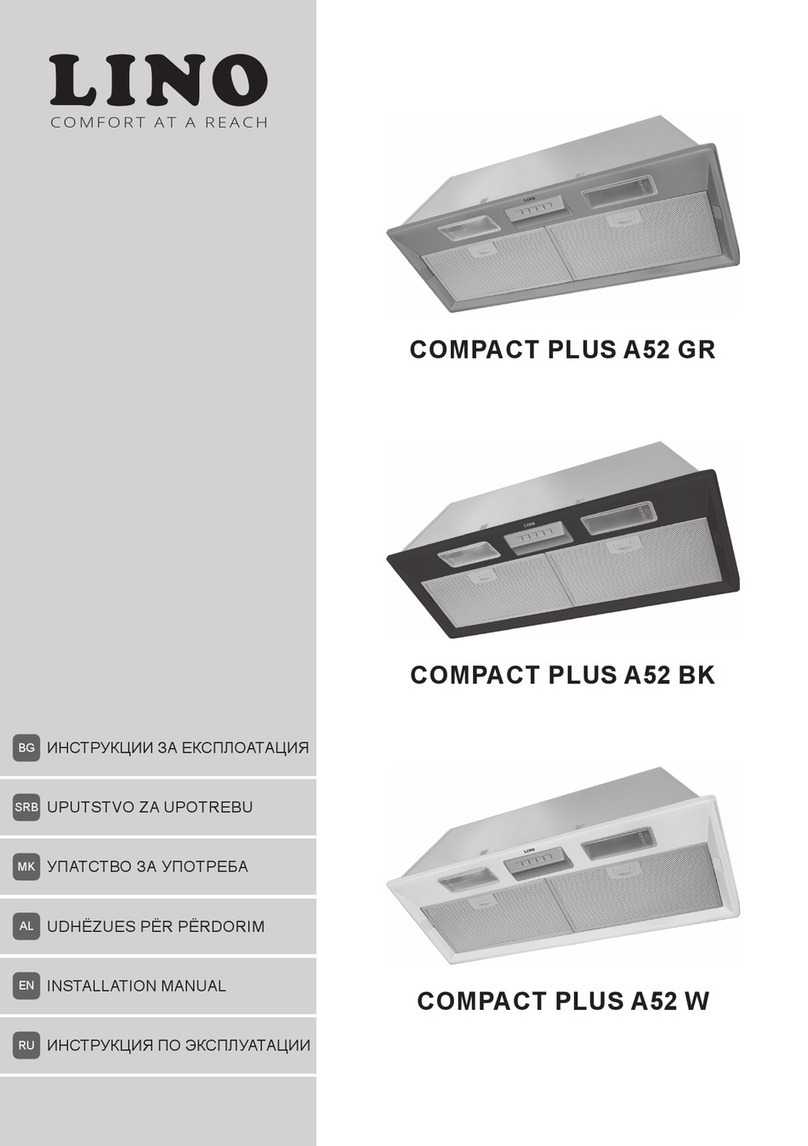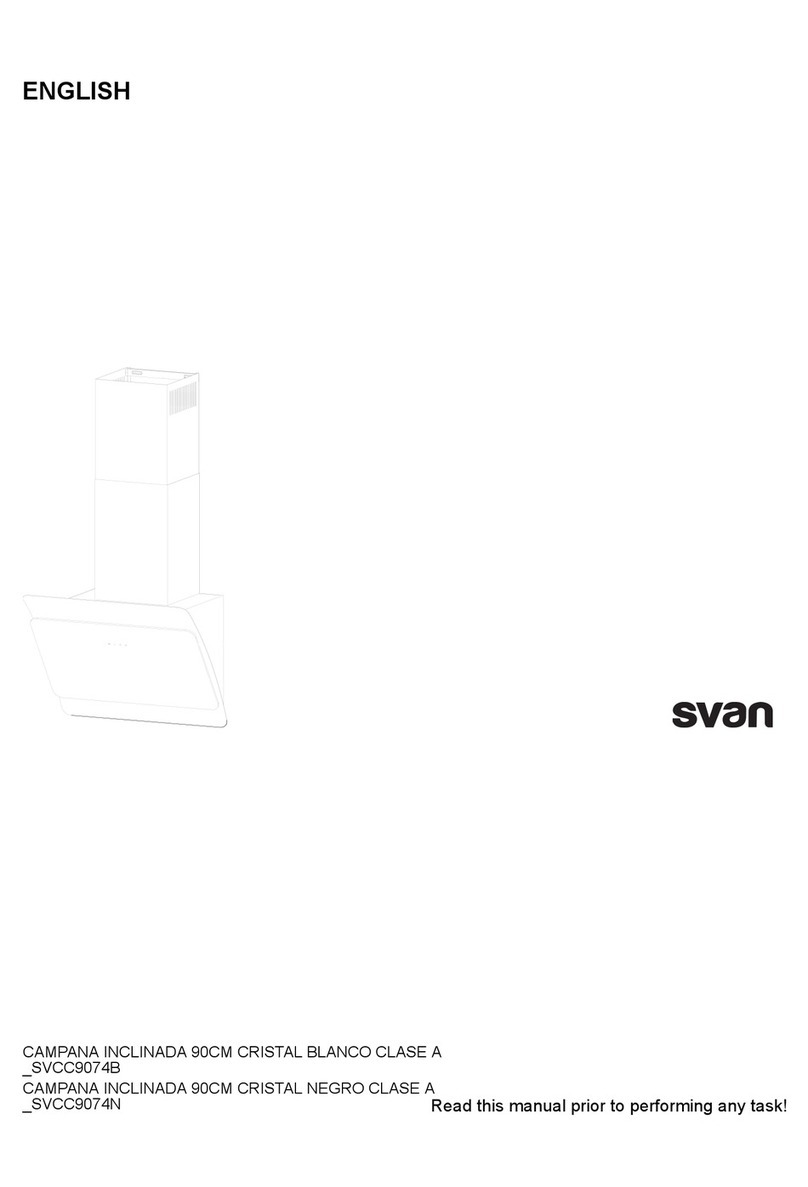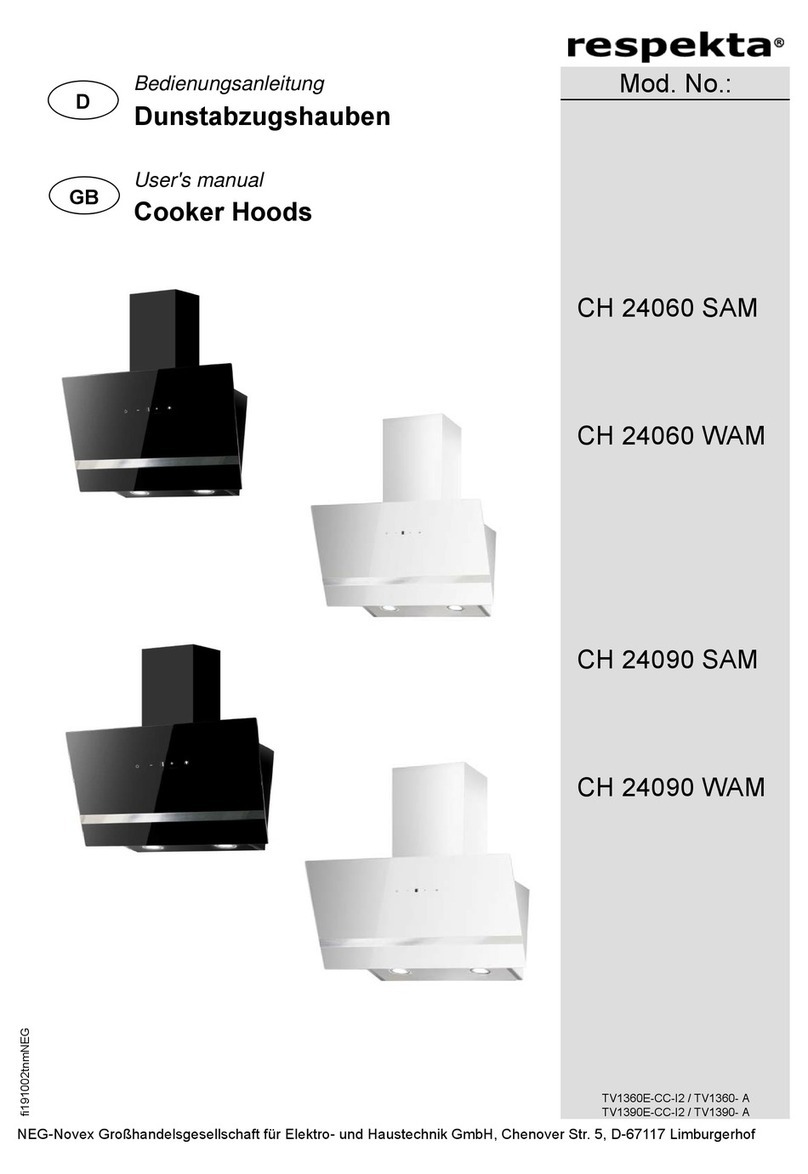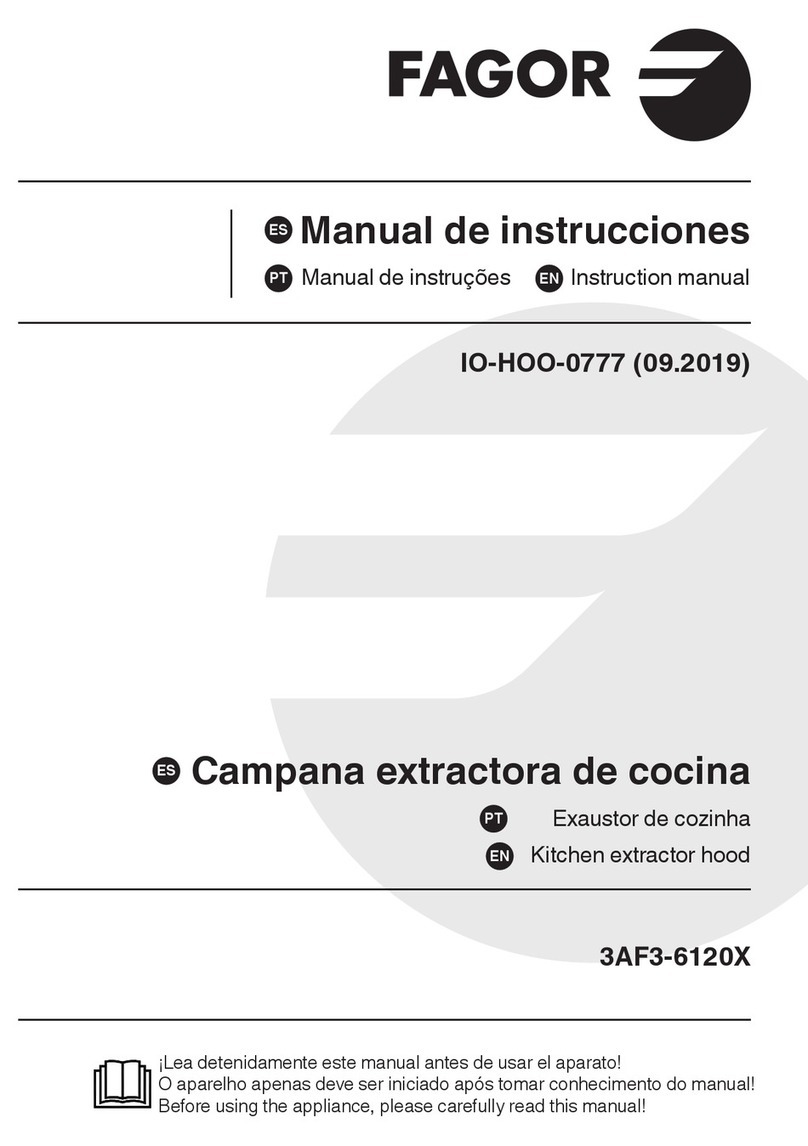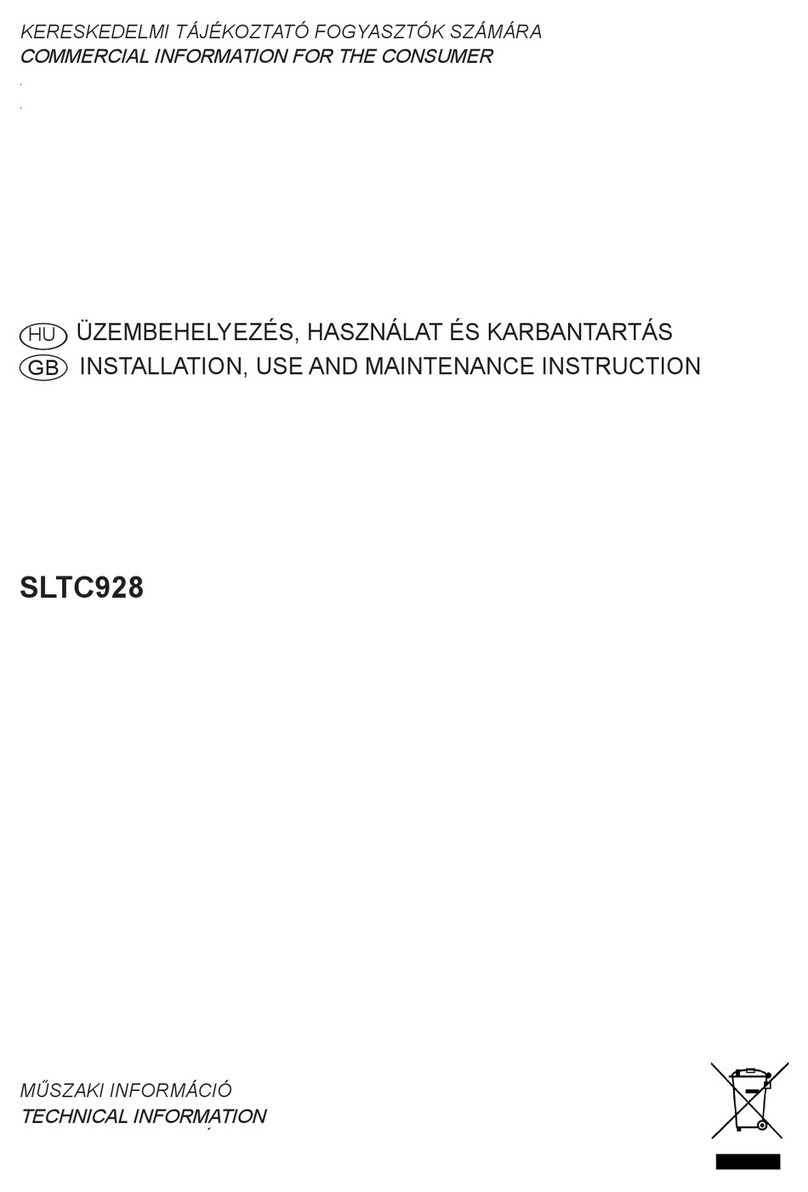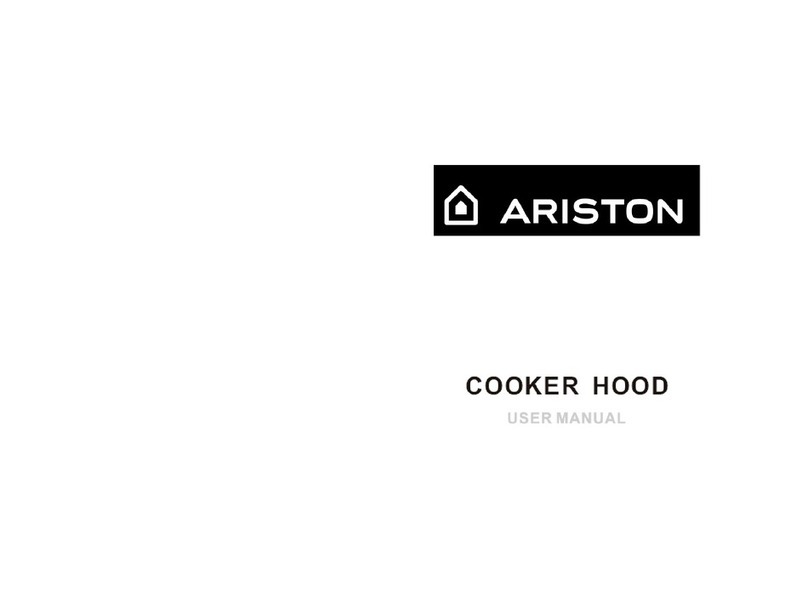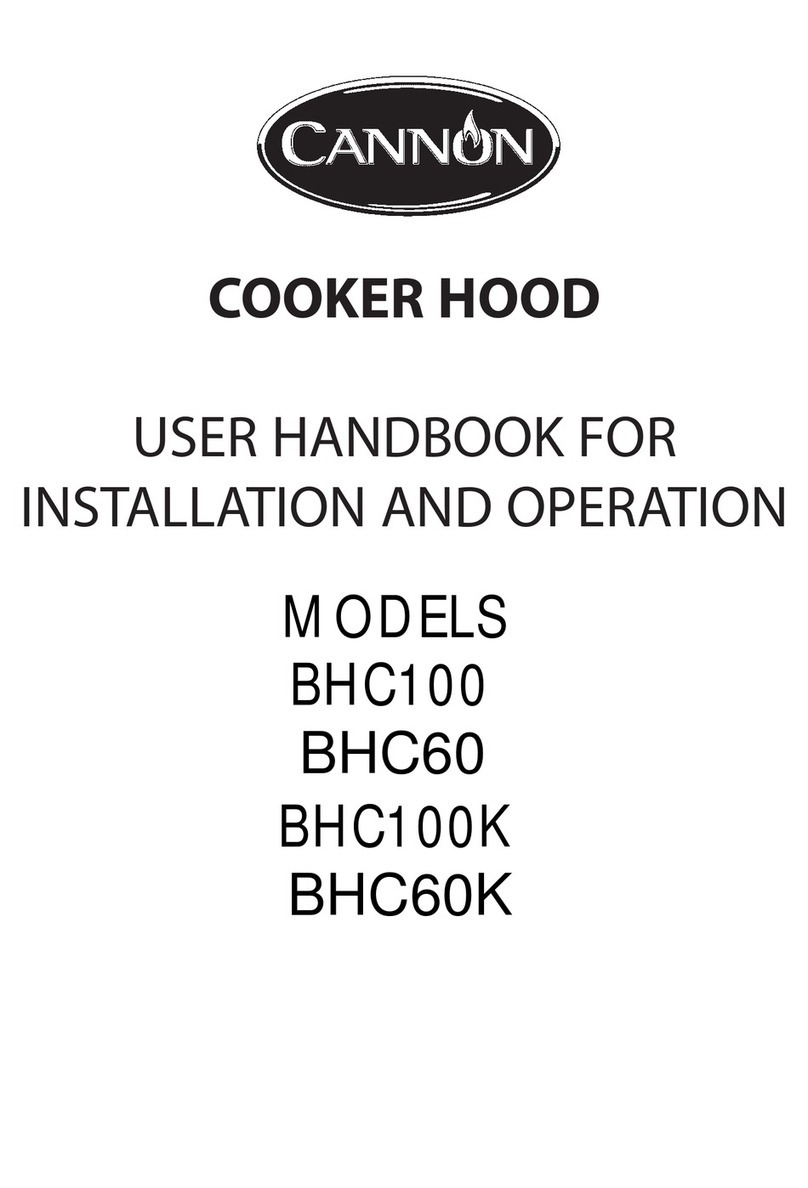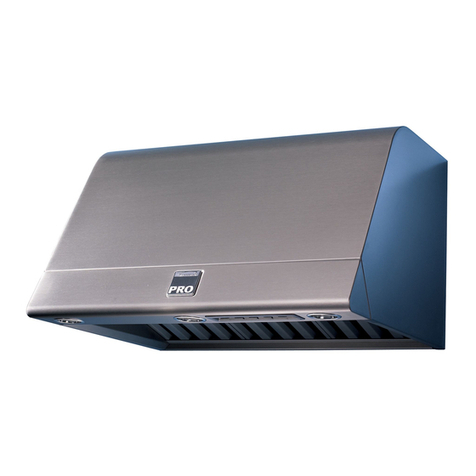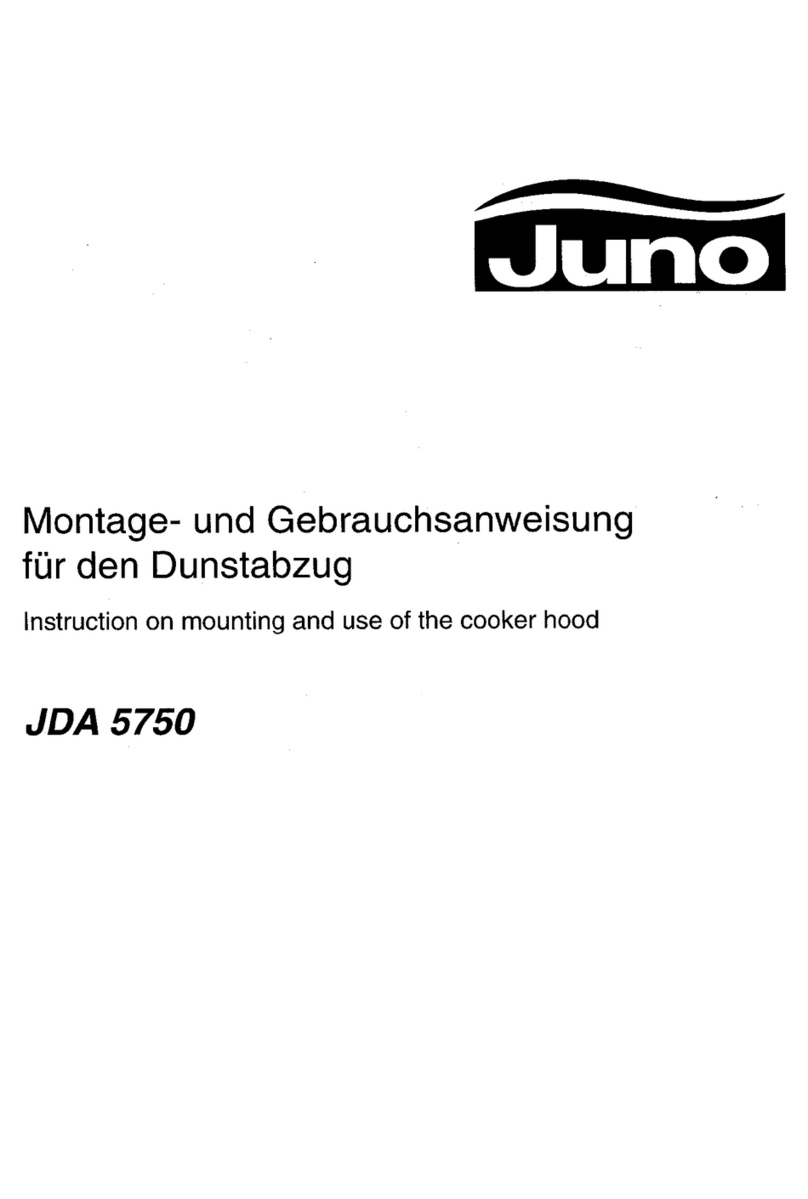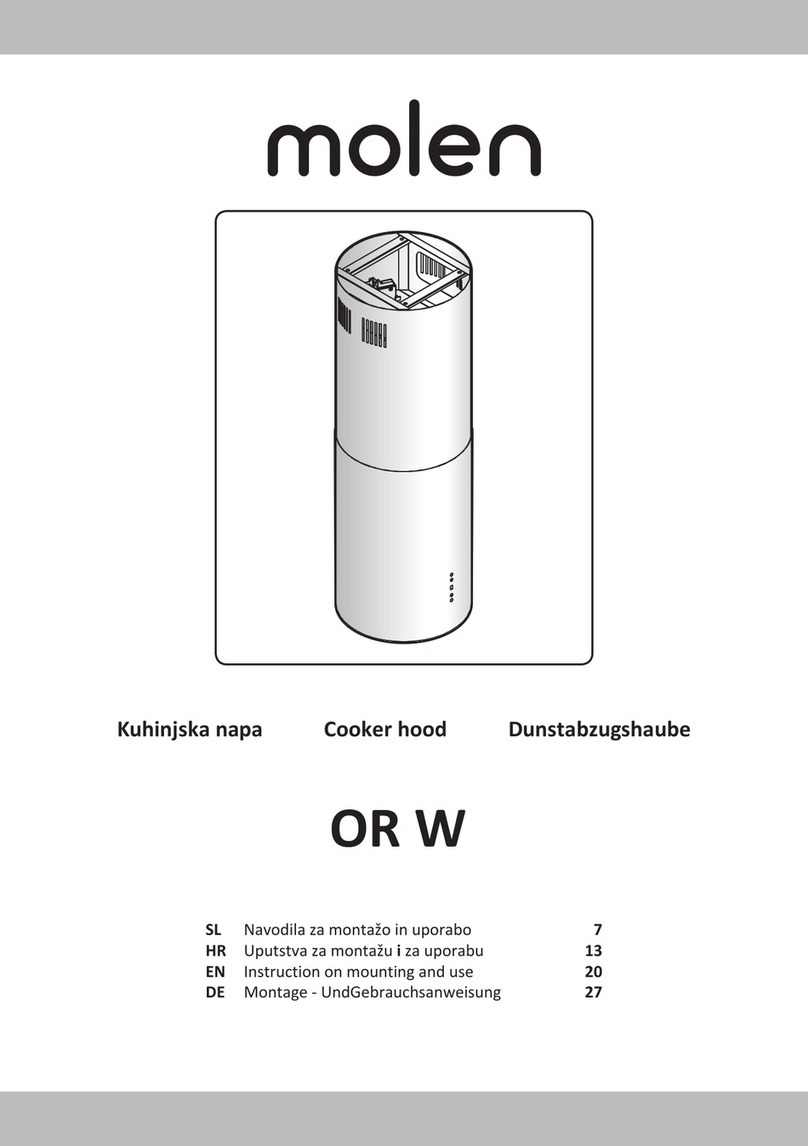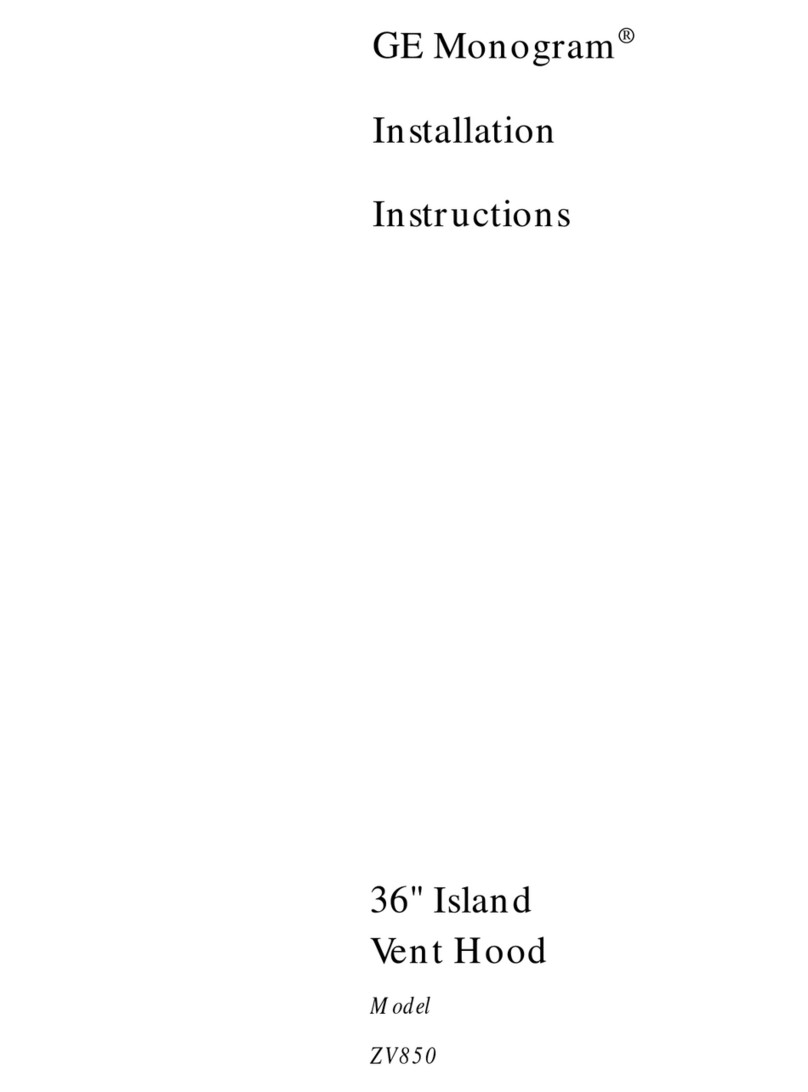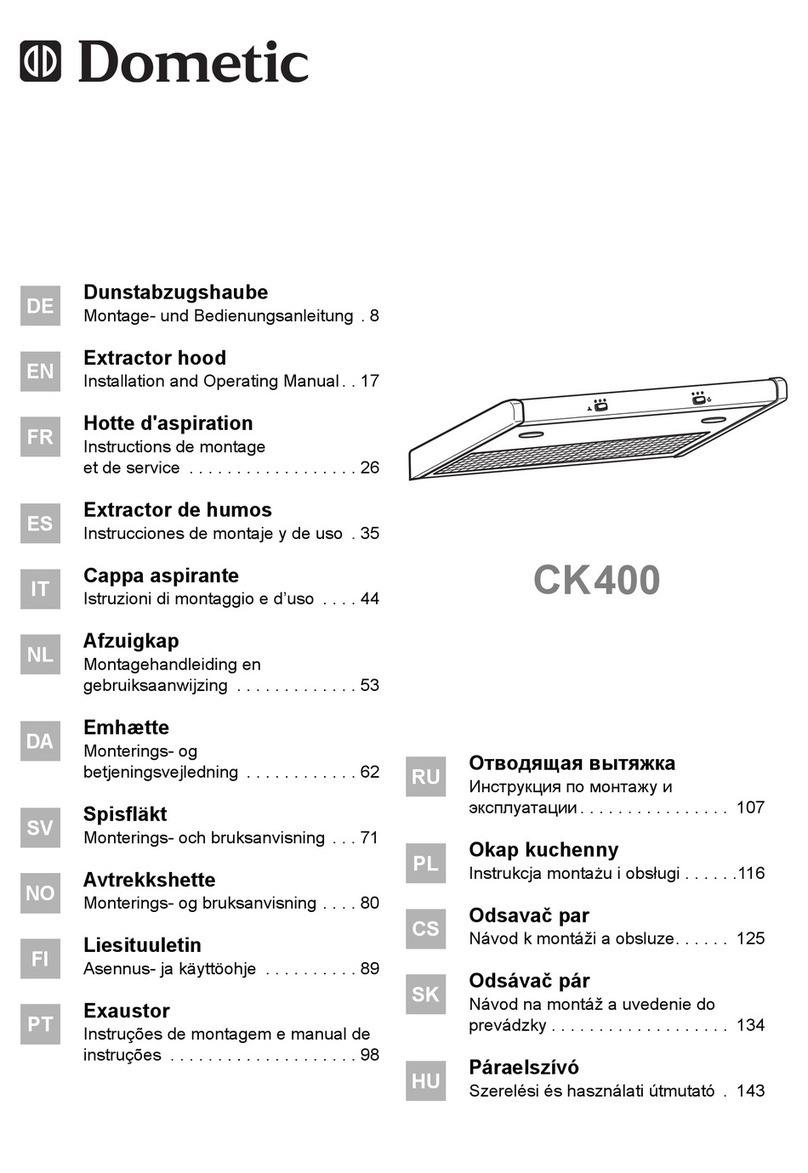hestan GVP Series Instruction and safety manual

OUTDOOR COOKING
Outdoor Vent Hood – Pro Canopy
GVP
Installation, Use and Care Manual

Do not store or use gasoline or other flammable vapors and liquids in the vicinity of this or
any other appliance.
Installation and service must be performed by a qualified installer or service agency.
DO NOT REPAIR, REPLACE OR REMOVE ANY PART OF THE APPLIANCE UNLESS
SPECIFICALLY RECOMMENDED IN THE MANUAL. IMPROPER INSTALLATION,
SERVICE OR MAINTENANCE CAN CAUSE INJURY OR PROPERTY DAMAGE. REFER
TO THIS MANUAL FOR GUIDANCE. ALL OTHER SERVICING SHOULD BE DONE BY A
HESTAN AUTHORIZED SERVICE TECHNICIAN.
READ THESE INSTRUCTIONS CAREFULLY AND COMPLETELY BEFORE
INSTALLING OR USING YOUR APPLIANCE TO REDUCE THE RISK OF
FIRE, BURN HAZARD, OR OTHER INJURY. KEEP THIS MANUAL FOR
FUTURE REFERENCE.
SAFETY DEFINITIONS
THIS INDICATES THAT DEATH OR SERIOUS INJURY MAY OCCUR
AS A RESULT OF NOT OBSERVING THIS WARNING
THIS INDICATES THAT MINOR OR MODERATE INJURY MAY
OCCUR AS A RESULT OF NOT OBSERVING THIS WARNING.
THIS INDICATES THAT DAMAGE TO THE APPLIANCE OR
PROPERTY MAY OCCUR AS A RESULT OF NOT OBSERVING THIS
WARNING.
INSTALLER: LEAVE THIS MANUAL WITH THE OWNER OF THE APPLIANCE.
HOMEOWNER: RETAIN THIS MANUAL FOR FUTURE REFERENCE.
IF THE INFORMATION IN THIS MANUAL IS NOT FOLLOWED
EXACTLY, A FIRE OR EXPLOSION MAY RESULT CAUSING
PROPERTY DAMAGE, PERSONAL INJURY, OR DEATH.

Message from Hestan:
Outdoor cooking is a perfectionist’s pursuit, and with your new investment,
you’ve now taken the ultimate step forward. We sincerely welcome you to
the Hestan Family. We’ve engineered and built our products so that your
guests will rave about your meal, but deep down, our customers know it
could’ve been just a little more tender, juicier – a pinch more salt in the rub
or a few seconds less on the flame. Yes, we’ve taken the time to know our
Hestan customer and we’re excited to be on this journey with you. Hestan
Outdoor was born from this same perfectionist passion. Our engineers
experimented, innovated, tweaked and tinkered until they created the most
powerful, versatile and reliable outdoor products available.
We pride ourselves on restless innovation, superior engineering and
purpose-built designs, but also our in-depth understanding of our target
consumer and the interests and needs of the ultimate end-users we serve
and covet. For many consumers, cooking outdoors is much more than an
act of food preparation. It’s a lifestyle activity that encompasses culinary,
leisure and social pursuits among others.
We are thankful and proud that you have chosen Hestan, and we yearn to
have you as a customer for life. We take your decision to choose Hestan
most seriously, and we promise to deliver the very best to you.
Welcome to Hestan Outdoor


ELECTRICAL SHOCK HAZARD
It is the responsibility of the user to have the appliance connected
by a licensed electrician in accordance with all applicable codes and
standards, including fire-related construction. See “Step 16 - WIRING
CONNECTION” on page17 for details.
ELECTRICAL SUPPLY AND GROUNDING
• This appliance must be grounded. See “Step 16 - WIRING CONNECTION” on page17 for
instructions.
• This appliance must be connected to 120 VAC Single Phase, 60 Hz, with a 20 amp dedicated
circuit.
• OWNER: Have the installer show you where the electric circuit breaker is located so you know
how to shut off the power to this appliance.
Suitable for use in covered outdoor applications when installed in a GFCI protected branch circuit.
TABLE OF CONTENTS
1 SAFETY PRECAUTIONS - BEFORE YOU BEGIN
4 MODEL NUMBERS
4 RATING LABEL
5 REGULATORY / CODE REQUIREMENTS
5 USING THE VENTILATION SYSTEM
6 CLEANING AND MAINTENANCE
9 TROUBLESHOOTING
10 DUCTING DO’S AND DON’TS
11 INSTALLATION
19 VENT ACCESSORIES
20 DUCT COVERS
21 PARTS / SERVICE
21 LIMITED WARRANTY
When properly cared for, your Hestan Outdoor ventilation system will provide safe, reliable service
for many years. When using this ventilation system, basic safety practices must be followed as
described in the following pages.
IMPORTANT: Save these instructions for the local Utility Inspector’s use.
INSTALLER: Please leave these Installation Instructions with the owner.
OWNER: Please read these Instructions and save them for future reference.
SAFETY PRECAUTIONS - BEFORE YOU BEGIN
©2019 Hestan Commercial Corporation
1
EN

GENERAL SAFETY PRECAUTIONS
When properly cared for, your new Outdoor Pro Canopy has been designed to be a safe, reliable
ventilation system. Read all instructions carefully before using this ventilation system. When using
cooking appliances, basic safety precautions must be followed.
TO REDUCE THE RISK OF FIRE, ELECTRIC SHOCK, OR INJURY TO
PERSONS, OBSERVE THE FOLLOWING:
a) Use this ventilation system only as intended by the manufacturer. If you have any questions,
contact the manufacturer.
b) Before servicing or cleaning unit, switch power off at service panel and lock the service
disconnecting means to prevent power from being switched on accidentally. When the service
disconnecting means cannot be locked, securely fasten a prominent warning device, such as a tag,
to the service panel.
FOR GENERAL VENTILATING USE ONLY. DO NOT USE TO
EXHAUST HAZARDOUS OR EXPLOSIVE MATERIALS AND VAPORS.
TO REDUCE THE RISK OF A GREASE FIRE:
a) Never leave burners or surface units unattended at high settings. Boilovers cause smoking and
greasy spillovers that may ignite. Heat oils slowly on low or medium settings.
b) Always turn hood ON when cooking at high heat or when flambéing food (i.e. Crepes Suzette,
Cherries Jubilee, Peppercorn Beef Flambé).
c) Clean ventilating fans frequently. Grease should not be allowed to accumulate on fan or filter.
d) Use proper pan size. Always use cookware appropriate for the size of the burner or surface
element.
TO REDUCE THE RISK OF INJURY TO PERSONS, IN THE EVENT OF
A GREASE FIRE, OBSERVE THE FOLLOWING *:
a) TURN OFF ALL BURNERS. If the fire is contained in a small area, you may attempt to
SMOTHER FLAMES with a close-fitting lid, cookie sheet, or metal tray. For a grill, closing the lid
may not always smother the flames. BE CAREFUL TO PREVENT BURNS. If the flames do not
go out, shut off the gas supply, EVACUATE AND CALL THE FIRE DEPARTMENT.
b) NEVER PICK UP A FLAMING PAN - You may be burned.
c) DO NOT USE WATER, including wet dish cloths or towels - a violent steam explosion will result.
d) Use an extinguisher ONLY IF:
1. You have a Class ABC or Class K fire extinguisher and you already know how to operate it.
2. The fire is small and contained in the area where it started.
3. The fire department is being called.
4. You can fight the fire with your back to an exit.
* Based on “Kitchen Fire Safety Tips” published by NFPA.
SAFETY PRECAUTIONS - BEFORE YOU BEGIN
(CONT.)
©2019 Hestan Commercial Corporation
2
EN

BURN HAZARD
This outdoor ventilation system is intended for use with Hestan or Aspire grills which can get very
hot during operation. Observe the warnings and cautions found in the grill manual.
This ventilation system should be serviced only by a Hestan authorized service technician. Contact
the nearest authorized service center for examination, repair or adjustment.
Do not repair or replace any part of the system unless specifically recommended. Refer service to an
authorized servicer.
Do not operate this ventilation system if it is not working properly or if it has been damaged, until an
authorized servicer has examined it.
Install or locate this ventilation system only in accordance with the Installation section of this
manual. Do not cover or block any openings on this ventilation system.
It is highly recommended that a suitable kitchen fire extinguisher (Class ABC or K) be readily
available and highly visible next to any outdoor cooking appliance.
SAFETY DURING CLEANING
Clean only ventilation system parts listed in this manual, in the manner specified in this manual.
Note: the “ventilating fans” and “filter” in the previous warnings refer to the blower wheel(s), blower
housing(s), and blower shield(s).
THIS MANUAL SHOULD REMAIN WITH THE HOMEOWNER FOR FUTURE REFERENCE.
SAFETY PRECAUTIONS - BEFORE YOU BEGIN
(CONT.)
©2019 Hestan Commercial Corporation
3
EN

RATING LABEL
The rating label contains important information about your Hestan appliance such as the model and
serial number, electrical rating and the minimum installation clearances.
The rating label is located on the blower housing.
If service is necessary, contact Hestan Customer Care
with the model and serial number information shown
on the label.
MODEL NUMBERS
MODEL
NO. DESCRIPTION BLOWER
PACKAGE RECOMMENDED
FOR GRILL SIZE
GVP42 42” Pro Canopy 900 cfm Outdoor Ventilation System WM2L Dual +
WM1L Single 30”
GVP48 48” Pro Canopy 1200 cfm Outdoor Ventilation System Two WM2L Duals 36”
GVP54 54” Pro Canopy 1200 cfm Outdoor Ventilation System Two WM2L Duals 42”
POWER AND FLOW RATINGS
Blower
Package Amps CFM
CFM ** CFM
Minimum
Round Duct
Size
Sones
***
WM2L Dual +
WM1L Single 4.4 900 1350 804 725 655 AKVT6810:
10” (79 in.
2
)6.3
Two WM2L
Duals 5.8 1200 1800 1062 960 860 AKVT8812:
12” (113 in.
2
)6.6
All units 115 VAC 60 Hz 1550 RPM
* Static Pressure in inches water column.
** When comparing the Hestan system with blower units made by other manufacturers, use the “Equivalent CFM”.
*** Ratings in accordance with the Standard Test Code by the Energy Systems Laboratory of the Texas Engineering
Experiment Station.
(serial number)
(model number)
Typical rating label Rating label location
©2019 Hestan Commercial Corporation
4
EN

FEATURES OF THE VENTILATION SYSTEM
Speed controls are provided for each blower assembly. Two-blower systems will have one speed
control knob, while three or four-blower systems will have two speed control knobs.
A control knob is provided for lighting intensity.
The controls layout will be similar to that shown below.
USING THE HOOD
The user can start with the a hood on the lowest setting, and then increase speed and/or turn
on additional blowers as required. Using the hood at high settings may increase heating or air
conditioning requirements and costs for the house.
BLOWER CONTROL KNOB
To operate the blower(s), rotate the knob through the blower speed settings by turning it clockwise
(facing the knob).
Rotate the knob counter-clockwise to reduce the blower speed.
LIGHT CONTROL KNOB
To operate the lights, rotate the knob through the light intensity settings by turning it clockwise
(facing the knob). Rotate the knob counter-clockwise to dim the lights or turn them off.
1
24
3
2
Installation of this ventilation system must be made in accordance with local codes. In the absence
of local codes, this unit should be installed in accordance with the National Electrical Code and local
codes.
This appliance must be electrically grounded in accordance with local codes or in the absence of local
codes with the National Electrical Code
ANSI/NFPA 70
, or Canadian Electrical code
CSA C22.1
.
USING THE VENTILATION SYSTEM
Controls for three and four blowers
Controls for two blowers
Item Function
1Blower control
2Light control
3Blower control
blowers 1 & 2
4Blower control
blower 3 or
blowers 3 & 4
REGULATORY / CODE REQUIREMENTS
©2019 Hestan Commercial Corporation
5
EN

CLEANING AND MAINTENANCE
CLEANING THE VENTILATION SYSTEM
Cleaning requirements depend completely on usage and environment. The more high-heat and/or
greasy cooking, the more often the hood and blower will need cleaning.
The grease tray and blower aren’t visible from the outside, so they must be removed for inspection.
After you’ve inspected the tray a few times over the course of six months or a year, you’ll be able to
set a cleaning schedule according to your usage pattern.
HOOD CANOPY
Wipe down the interior and exterior of the hood as needed with a soft cloth and warm soapy water
(liquid dish detergent is acceptable). Do not use acids, abrasives, strong detergents, solvents, or
scouring pads. Stainless steel should be treated with a quality stainless steel cleaner such as Stainless
Steel Magic®. Follow all label instructions. Do not polish across the grain or in circles.
BLOWER HOUSING AND SHIELD
To reduce the risk of personal injury, be sure the power is turned off in
the hood before removing the shield(s) and blower housing(s).
The blower captures grease by-products in the blower housing(s) and blower shield(s). The blower
shields require more frequent cleaning than the blower housing, but cooking usage determines how
often each item will need to be cleaned.
Item # Description
1Blower housing with damper(s)
2Blower shield
BLOWER SHIELD REMOVAL
The blower shields are easily removed for cleaning by pulling the blower shield(s) toward the front of
the hood.
Be careful to keep the tray level if the hood has been recently used and the
grease might still be warm.
Inspect and clean the blower shield (Details follow)
BLOWER HOUSING REMOVAL
To remove the blower housing:
1. Unsnap two suitcase latches, one on each side of the housing.
2. Support the housing and pull it away from the blower base.
3. While pulling it back, gently “tip” it downward to clear the blower wheel(s).
1
2
©2019 Hestan Commercial Corporation
6
EN

CLEANING
Clean the shield(s) and/or blower housing(s) in a sink of warm soapy water (liquid dish detergent)
and let soak for a few minutes. Wash with a sponge or dishcloth, rinse and let drain before
reinstalling. Alternatively, the blower housing(s) and blower shield(s) may be placed into a
dishwasher.
Item # Description
1Motor housing
2Wheel
3Blower housing with damper(s)
4Blower shield
To reduce the risk of personal injury, be sure the power is turned off in
the hood before removing the shield(s) and blower housing(s).
Regular cleaning of the blower housing should prevent grease accumulation on the blower wheel. If
grease build-up should occur, the blower wheel may easily be cleaned in place using a soft bristle
toothbrush and a common degreaser such as Formula 409®.
Take care not to move or lose the metal balancing clips that may be affixed to
the wheel.
Item # Description
1Balancing clip
2Blower wheel
2
1
4
3
1
2
CLEANING AND MAINTENANCE
(CONT.)
©2019 Hestan Commercial Corporation
7
EN

CLEANING AND MAINTENANCE
(CONT.)
BLOWER WHEEL REMOVAL
For instances where the blower wheel must be removed, follow the instructions below.
• Removing the blower wheel requires a 1/8” hex wrench. This may be obtained from your local
hardware store or tool supply.
The wheel is retained by a set screw on the side of the hub of the wheel that tightens up against a
“flat” spot on the motor shaft.
1. Locate the set screw on the side of the hub of the wheel.
2. Insert wrench through the blades of the blower wheel and into the set screw.
3. Loosen the set screw 1/2 turn counterclockwise.
If the wheel is difficult to remove, the area where the motor shaft makes contact with the blower
wheel hub may need to be sprayed with a common penetrating oil such as WD-40®.
After allowing the penetrating oil to soak for a few minutes, push the blower wheel forward
slightly, then gently pull the blower wheel off the motor shaft.
• Use caution to avoid bending or distorting the blower wheel and take care not to move or lose
the metal balancing clips that may be affixed to the wheel.
A soft bristle toothbrush with warm soapy water may be used to clean the blades, or soak the blower
wheel in warm soapy water.
BLOWER WHEEL INSTALLATION
When reinstalling the wheel onto the motor shaft, make sure the set screw makes direct contact
with the “flat spot” on the motor shaft.
1. Slide the blower wheel onto the motor shaft as far as it will go, making sure the back of the
blower wheel does not touch the motor mount screws protruding from the motor.
• If the motor is too far back, it will rub the motor mount screws, and if it is too far forward, it will
rub the inside of the blower housing.
2. Adjust the blower wheel slightly to find the correct front-to-rear location.
3. Tighten the set screw (clockwise) to lock the blower wheel in the correct position.
For hoods that have more than one blower wheel, make sure that white blower
wheels are matched up with white motor rings, and black blower wheels are
matched up with black motor rings.
The hood will not perform properly if blower wheels and motors are mismatched.
MOTOR REPLACEMENT
To reduce the risk of personal injury, turn off power to the hood at
the breaker or the circuit disconnect before attempting to remove the
blower motor.
MOTOR IDENTIFICATION AND POSITIONING
Motors are color-coded; black and white motors have different rotations and must be installed in the
correct positions.
• Housings with a single blower use a white blower and wheel.
• Housings with two blowers use a white blower on the right and black on the left.
Make sure you have the correct motor in each housing position.
©2019 Hestan Commercial Corporation
8
EN

TROUBLESHOOTING
If the hood does not perform satisfactorily, check the following:
• Do the blowers run?
• Are the blower wheels installed on the correct motors? (black wheel on black motor, white wheel
on white motor)
• Are the motor and wheel assemblies installed in the correct locations?
• Check the damper doors in hood behind/above blowers - do they move/open freely?
• Check the dampers/vents to outside - do they open freely, with no obstructions?
• Check for damaged or obstructed ductwork.
• If the replacement blower motor includes a blower wheel, then you can remove the motor and
wheel together. If you will re-use your existing wheel, then you may wish to remove the wheel
before removing the motor.
1. Remove the shield and blower housing as described in
“BLOWER WHEEL REMOVAL” on page8.
2. Use a ¼” nut driver to remove the three motor mount
screws that attach the motor to the base.
3. Gently pull the motor forward and down.
4. Disconnect the wiring harness, remove the old motor.
• To avoid damage to the blower wheel, you may wish
to install the motor and then install the wheel onto
the motor.
5. Lift the new motor so you can connect the wiring
harness. Be sure to fully engage the electrical
connections and tighten the motor mount screws.
6. Check the blower wheel clearance and adjust as needed,
as described in “BLOWER WHEEL INSTALLATION” on
page8.
CLEANING AND MAINTENANCE
(CONT.)
©2019 Hestan Commercial Corporation
9
EN

DUCTING DO’S AND DON’TS
©2019 Hestan Commercial Corporation
10
EN
GENERAL REQUIREMENTS
Observe local codes regarding special duct requirements and placement of duct work against
combustibles.
• Using recommended transitions (see VENT ACCESSORIES) will ensure proper efficiency.
• Using recommended roof caps or wall louvers (see VENT ACCESSORIES) will ensure proper
efficiency.
• Use foil HVAC tape (not grey cloth duct tape) to seal all joints.
• The hood must be ducted to the outdoors without restrictions.
BLOWER REQUIREMENTS
The dual blower unit (WM2L, used in all systems) requires 8” round duct or equivalent (50 square
inches). The single blower unit (WM1L, used in addition to the dual blower unit in 900 CFM
systems) requires 6” round duct or equivalent (28 square inches).
COMBINED DUCT SIZE AFTER A TRANSITION
Single and Dual (WM1L & WM2L) combine to 10” round or equivalent 79 sq. in. using a multi-blower
transition such as AKVT6810 (Optional).
Two Duals (Two WM2Ls) combine to 12” round or equivalent 113 sq. in. using a multi-blower
transition such as AKVT8812 (Optional).
DUCTING REQUIREMENTS (DO’S AND DON’TS)
• NEVER reduce the duct size. When combining ducts together, the square inch area of the outlet
duct must be equal or greater than the total square inch area of the ducts being combined.
• Only use smooth, galvanized, metal duct. Do not use flexible or corrugated duct. This type of
duct will restrict airflow and reduce performance.
• Make the duct run as short and as straight as possible with as few turns as possible.
• Avoid sharp-angled turns. Instead, use smooth, gradual turns such as adjustable elbows or 45
degree angled turns.
• For duct runs over 20 feet, increase the duct diameter by one inch for every ten feet of duct.
• When planning length, a 90 degree elbow is equivalent to 5 feet of duct.
TERMINATION REQUIREMENTS
Airflow must not be restricted at the end of the duct run.
A wall louver or roof cap is required for each duct run.
Every wall louver or roof cap must include a gravity damper to prevent back drafts.
Do not use screen wire or spring-
loaded doors on wall louvers or roof
caps.
Do not terminate venting into an attic
or chimney. Smooth duct Smooth gradual turn Proper combining
of two ducts
YES
NO
Flexible duct Sharp angled turns of two ducts
Improper combining

INSTALLATION
TO REDUCE THE RISK OF FIRE, ELECTRIC SHOCK, OR INJURY TO
PERSONS, OBSERVE THE FOLLOWING:
a) Installation work and electrical wiring must be done by qualified person(s) in accordance with all
applicable codes and standards, including fire-rated construction.
b) Sufficient air is needed for proper combustion and exhausting of gases through the flue
(chimney) of fuel burning equipment to prevent back drafting. Follow the heating equipment
manufacturer’s guideline and safety standards such as those published by the National Fire
Protection Association (NFPA), and the American Society for Heating, Refrigeration, and Air
Conditioning Engineers (ASHRAE) and the local code authorities.
c) When cutting or drilling into wall or ceiling, do not damage electrical wiring and other hidden
utilities.
d) Ducted fans must always be vented to the outdoors.
TO REDUCE THE RISK OF FIRE, USE ONLY METAL DUCTWORK.
TO REDUCE THE RISK OF FIRE OR ELECTRICAL SHOCK, DO NOT USE THIS BLOWER WITH
ANY SOLID-STATE SPEED CONTROL DEVICE.
INSTALLATION DETAILS
Read all instructions thoroughly before beginning installation. These instructions apply to Hestan
outdoor hoods, when mounted over a Hestan or Aspire grill. YOU MUST FOLLOW THE GRILL
CLEARANCES DESCRIBED IN YOUR GRILL INSTALLATION MANUAL.
FOR NON-COMBUSTIBLE LOCATIONS ONLY!! This appliance is wall-mounted and must NOT
be installed on or next to unprotected combustible construction. A minimum clearance to vertical
combustible material, such as adjacent walls, is 12” [30 cm] on the sides of the appliance (see Fig. 1).
ALL construction materials in the wall immediately behind the vent and the appliance below (usually
a grill), and within the 12” [30 cm] zone must be non-combustible. As an example, if you have a
stucco or tiled surface and wood-frame construction beneath, or wood-frame walls adjacent or
behind, the wood is considered combustible, even though the vent or grill is touching the stucco or
tiled surface, which is non-combustible. In extreme circumstances, the wood could potentially get
hot enough to burn.
Similarly, if you have the hood mounted over a free-standing grill which is parked close to these
surfaces when grilling over an extended period of time, enough radiant heat could reach the wood
and potentially get hot enough to burn, in extreme circumstances.
Construction materials such as metal studs with cement board and stucco/stone surfaces are ideal for
this application.
A minimum of 5” [12.7 cm] clearance behind the grill is needed to open the hood, and to adequately
capture smoke and vapors from the cooking area.
See Fig. 1 on the next page for details.
©2019 Hestan Commercial Corporation
11
EN

1. Read all instructions thoroughly before beginning installation. See “DUCTING DO’S AND
DON’TS” on page10.
• Weight and size: For safe installation, at least two people should be present to lift and hold the
hood. For larger hoods and installations with duct covers, it is advisable to have a third person
present to assist.
• Back Venting: If venting out the wall behind the vent instead of venting through the ceiling, see
“Back Venting” on page18 for details.
2. When installing a wall mount range hood, it is recommended that the bottom edge of the hood
be located 30” [76.2 cm] above the cooking surface for optimum performance.
3. Select the appropriate installation method.
Method 1 is suitable for applications where the top of the hood (blower outlet(s) location) is
accessible after the hood is mounted on the wall and when a Hestan duct cover will be used.
• NOTE: Since Hestan duct covers can be opened for access, they can be installed with the hood
and still permit access to connection points. The duct cover frame requires that the hood and
duct cover be installed together.
Method 2 is suitable for applications where the top of the hood (blower outlet(s) location) is not
accessible after the hood is mounted on the wall.
Make sure that once the hood is mounted the motor cooling vents are
not obstructed.
INSTALLATION
(CONT.)
34.6”
[87.9]
NON-COMBUSTIBLE
CONSTRUCTION
ISLAND VENT
OPENINGS
W
DUCT
OUTLETS
NOTES:
* SHADED AREA INDICATES WHERE COMBUSTIBLE MATERIALS ARE NOT ALLOWED.
* "W" IS THE WIDTH OF THE GRILL.
NON-COMBUSTIBLE CONSTRUCTION ONLY
(HESTAN GRILL SHOWN)
18”
[45.7]
27.4”
[69.7]
18.3”
[46.5]
30”
[76.2]
REF.
5”
[12.3]
MIN.
12”
[30.5] 12”
[30.5]
6”
[15.1] 6”
[15.1]
30”
[76.2]
36”
[91.4]
REF.
GRILL
WIDTH
RECOMMENDED
VENT HOOD
30" [76.2] GVP42
36" [91.4] GVP48
42" [106.7] GVP54
Fig. 1
12”
[30.5]
©2019 Hestan Commercial Corporation
12
EN

4. IF THE HOOD IS TO BE “BACK VENTED”, PROCEED DIRECTLY TO STEP 5.
Consult the connection diagrams (following) for further details on exhaust outlet placement.
Method 1: Install the duct(s) from the outside of the home down to the location of the exhaust
outlet(s) on the top of the hood or to the transition (if applicable).
• If a transition is used, install duct down to the location of the transition outlet plus 1”
[2.5 cm]. This will allow the transition to engage 1” [2.5 cm] inside of duct.
Method 2: Install the duct(s) from the outside of the home to the ceiling over the exhaust
outlet(s) on the hood. The end of the duct(s) should extend 1” [2.5 cm] below the
ceiling.
Use foil HVAC tape (not grey cloth duct tape) to seal all joints. See “Vent Accessories” on
page19 for a listing of available Hestan ducting materials.
TRANSITION HEIGHTS:
Single and Dual Blower (WM1L + WM2L = 900 CFM): 6” round duct will connect directly to
the top of the hood; 8” round will connect directly to the top of the hood. If using
the optional multi-blower transition (AKVT6810, sold seperately), a 10” round duct
connects to it 17-1/2” above top of hood. See “VENT ACCESSORIES” on page19
for details.
Two Dual Blowers (Two WM2Ls = 1200 CFM):
Two 8” round ducts connect directly to the top of the hood. If using the optional
multi-blower transition (AKVT8812, sold seperately), a 12” round duct connects to it
16-1/2” above top of hood. See “VENT ACCESSORIES” on page19 for details.
CONNECTION DIAGRAMS
8" Round
Connection Diagram (42” width)
WM2L Dual + WM1L Single Blower (900 CFM)
(Top View)
(Wall Side)
Centerline
of hood
Electrical (2)
Motor
Cooling
Vent (3)
6" [15.2 cm]
Round
7-5/16"
[18.6 cm] 1-7/8"
[4.8 cm]
5-1/4"
[13.3 cm] 1-3/4"
[4.4 cm]
7-5/16"
[18.6 cm]
5-1/2"
[14 cm]
Electrical (2
)
Connection Diagram (48-54” widths)
Two WM2L Dual Blowers (1200 CFM)
(Top view)
(Wall Side)
Centerline
of Hood
Motor
Cooling
Vent (4)
8" [20.3 cm]
Round
5-1/2"
[14 cm]
1-3/4"
[4.4 cm] 5-1/4"
[13.3 cm]
11"
[29.9 cm] 11"
[29.9 cm]
8" [20.3 cm]
Round
INSTALLATION
(CONT.)
©2019 Hestan Commercial Corporation
13
EN

5. Remove the hood from its packaging and place the back of the hood on the floor or countertop
in front of the wall where it will hang.
6. With the hood on its back facing you, remove the blower shield(s) and blower housing(s) as
follows:
a) Remove the shipping tape that is securing the blower shield(s) inside the hood.
b) Remove the blower shield(s) by lightly pulling it toward the front of the hood.
c) Gently close the back draft damper(s) from the top side of the hood.
d) To remove the blower housing(s), unsnap the suitcase latches (one on each side of the
housing).
e) Support the housing and lift it away from the blower base, then tip it back toward you to
clear the blower wheel(s), and then pull it from the hood.
Make sure power is off at the supply panel / breaker during service or
installation.
7. One blower motor must be removed from each blower assembly to access the connection
box(es). The blower assembly will have a decal identifying the location of the connection
box(es). It is not necessary to remove the blower wheel from the motor.
a) Remove the three screws retaining the blower motor.
b) Pull the motor out far enough so you can reach its electrical connector.
c) Unplug the connector, set the blower motor and screws aside.
8. WIRING PREPARATION:
a) Install an appropriate 1/2” UL listed electrical wire clamp through each motor box
electrical opening on top of the hood.
b) Install electrical wiring from the service panel to the hood location for each motor box.
Consult the connection diagrams (on previous page) for further details on electrical
placement. See “ELECTRICAL SUPPLY AND GROUNDING” on page1 for power
requirements.
Method 1: Extend wiring to 30” [76.2 cm] above the countertop. Electrical connection(s)
will occur after the hood is installed on the wall.
Method 2: Extend wiring to the hood. Electrical connection(s) will occur before the
hood is installed on the wall.
9. Mark the wall at the lower edge of the hood opening:
a) If using a duct cover:
i. Carefully remove the knockouts from the top four corners of the hood.
ii. Remove the duct cover from its packaging and remove the mounting screws from the
base of the duct cover.
iii. Place the duct cover on the top of the hood and secure it temporarily through the knock-
out openings using the mounting screws previously removed.
• The front panel may be removed from the duct cover during handling to reduce
weight.
b) Lift the hood (and duct cover assembly if used) to the location on the wall where it will be
installed.
INSTALLATION
(CONT.)
©2019 Hestan Commercial Corporation
14
EN

INSTALLATION
(CONT.)
c) Lightly mark the wall with a short, horizontal mark along the bottom edge of the hood.
d) When finished, remove the hood and duct cover assembly from the wall.
10. Find location of mounting strip:
a) On the back side of the hood, measure the distance between the bottom edge of the hood
and the top edge of the wood mounting strip.
b) Measure this distance above the horizontal mark made in Step 9 and lightly mark the wall
with a level, horizontal line.
c) Measure where the center (left to right) of the hood will be and mark the upper,
horizontal line on the wall with a short, vertical centerline.
11. Attach the mounting strip to the wall as follows:
a) Remove the screws inside the top of the back of the hood that retain the wood strip that
is recessed in the mounting channel. Note: Some retaining screws may be located behind
the blower(s).
b) Remove the wood mounting strip from the back of the hood and place the top edge of the
strip on the upper, level, horizontal line on the wall.
c) Referencing the vertical centerline from Step 10, place the mounting strip on the wall so
it is centered (left to right) in the space where the hood will be located. Mark the strip at
two or more stud locations, and drill clearance holes in the strip to prevent splitting.
d) Using proper hardware, attach the mounting strip to at least two wall studs.
Note: for 48” [122 cm] and larger hoods, three screws into studs are recommended.
12. FOR BACK VENTING APPLICATIONS ONLY. IF NOT BACK VENTING, PROCEED DIRECTLY
TO STEP 13.
• Note: Wall studs may interfere with back venting installations. Additional framing may be
required. It is necessary to cut duct access hole(s) in the wall prior to installing the hood.
• If using a duct cover, this step may be done with the duct cover removed from the hood. The
duct cover must still be mounted to the hood before mounting the hood to the wall.
Method 1:
a) Hold the hood on the mounting strip by aligning the channel at the top of the back of the
hood over the wood mounting strip on the wall.
b) Place the appropriate elbow(s) on top of the hood in line with the hood exhaust collar(s).
On the wall, trace around the elbow(s). Remove the hood and elbow(s) from the wall.
c) Cut around the outside of the traced line(s), avoiding wall studs. Install the duct from the
outside of the home to the opening in the wall. Use HVAC foil tape (not grey cloth duct
tape) to seal joints.
d) Proceed to step 14.
Method 2:
a) Use the the connection diagrams (page13), “BACK VENTING” on page18 , and
“VENT ACCESSORIES” on page19 as a guide. Install the duct(s) from the outside of
the home to the wall so they will meet the exhaust elbows to be used.
b) The end of the duct(s) should extend 1” past the ends of the elbows.
c) Proceed to step 14.
©2019 Hestan Commercial Corporation
15
EN

13. Check mount holes to wood strip, drill if needed:
a) Hang the hood on the mounting strip by aligning the channel at the top of the back of the
hood over the wood mounting strip on the wall.
b) While holding the hood in place, determine if the mounting holes in the channel at the top
of the back of hood align with the existing holes in the mounting strip. If they don’t, mark
the hole locations on the mounting strip.
c) Remove the hood and drill 3/32” pilot holes in the center of the marks in the wooden
mounting strip to avoid splitting.
14. MOUNTING THE HOOD:
FOR BACK VENTING APPLICATIONS ONLY. IF YOU ARE NOT BACK VENTING, PROCEED
DIRECTLY TO STEP 15.
• If using a Hestan duct cover, it must be mounted to the hood using the provided fasteners before
continuing.
Method 1:
a) Place the appropriate elbow(s) on the top of the hood. Elbow(s) should be placed with
the non-crimped end(s) on the inside of the collar(s) of the exhaust outlet(s). Use HVAC
foil tape (not grey cloth duct tape) to seal joints.
b) Lift the hood up to the wall and hang the hood on the mounting strip, taking care to
properly align the duct connection(s) between the elbow(s) and the duct(s) in the wall.
c) Secure the hood to the mounting strip by installing the screws (previously removed from
the strip in Step 11) into the pilot holes drilled in Step 13.
• Caution must be taken to avoid scratching the hood or ceiling.
Method 2:
a) Place the appropriate elbow(s) on the top of the hood. Elbow(s) should be placed with
the non-crimped end(s) on the inside of the collar(s) of the exhaust outlet(s). Use HVAC
foil tape (not grey cloth duct tape) to seal joints.
b) Insert the electrical wire from the service panel into the electrical wire clamp on each
motor box. Tighten the wire clamp(s).
c) While securing the slack in the wire, lift the hood up to the wall and hang the hood on the
mounting strip, taking care to properly align the duct connection(s) between the elbow(s)
on the hood and the duct(s) in the wall.
d) Secure the hood to the mounting strip by installing the screws (previously removed from
the strip in Step 11) into the pilot holes drilled in Step 13.
• IF BACK VENTING, SKIP STEP 15. PROCEED DIRECTLY TO STEP 16.
15. Mounting the Hood, NON-Back Venting:
If using a transition, install it on the insides of the exhaust collars and seal with HVAC tape (not
grey cloth duct tape). Then mount the hood as follows:
Method 1:
a) Lift the hood (and duct cover, if used) up to the wall and hang the hood on the mounting
strip, taking care to properly align the duct connection(s) between the hood and the duct
in the ceiling.
b) Secure the hood to the mounting strip by installing the screws (previously removed from
the strip in Step 11) into the pilot holes drilled in Step 13.
INSTALLATION
(CONT.)
©2019 Hestan Commercial Corporation
16
EN
This manual suits for next models
1
Table of contents
Languages:
Other hestan Ventilation Hood manuals
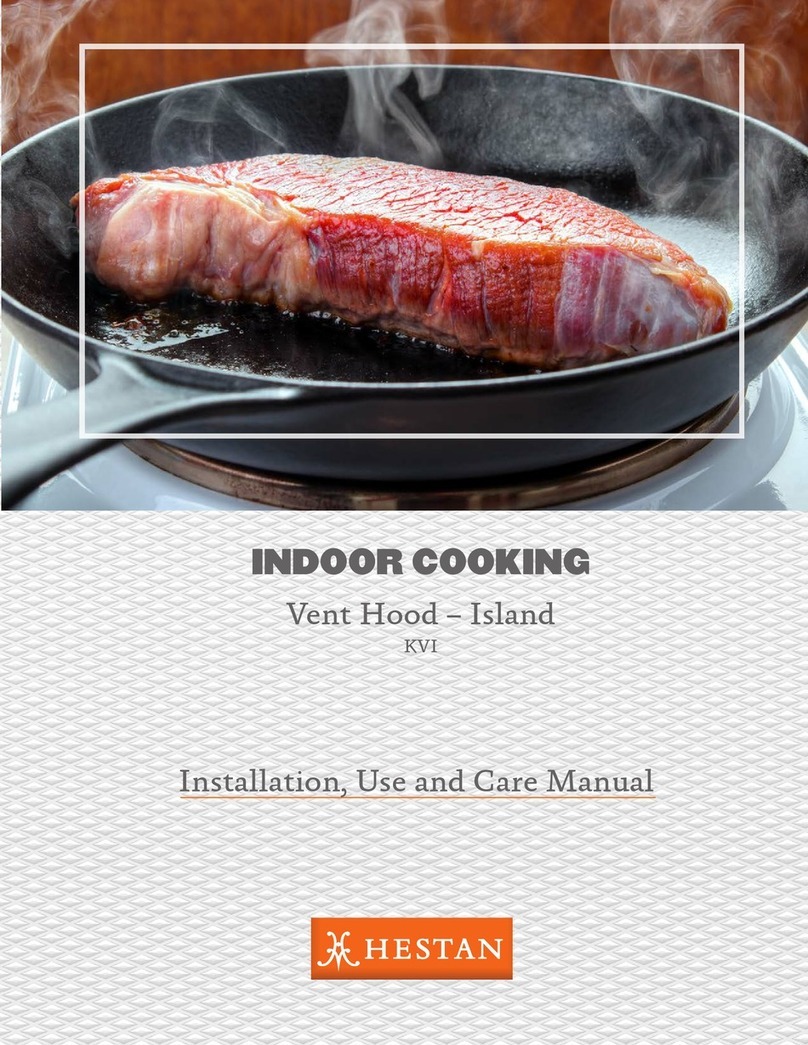
hestan
hestan KVI Series Instruction and safety manual
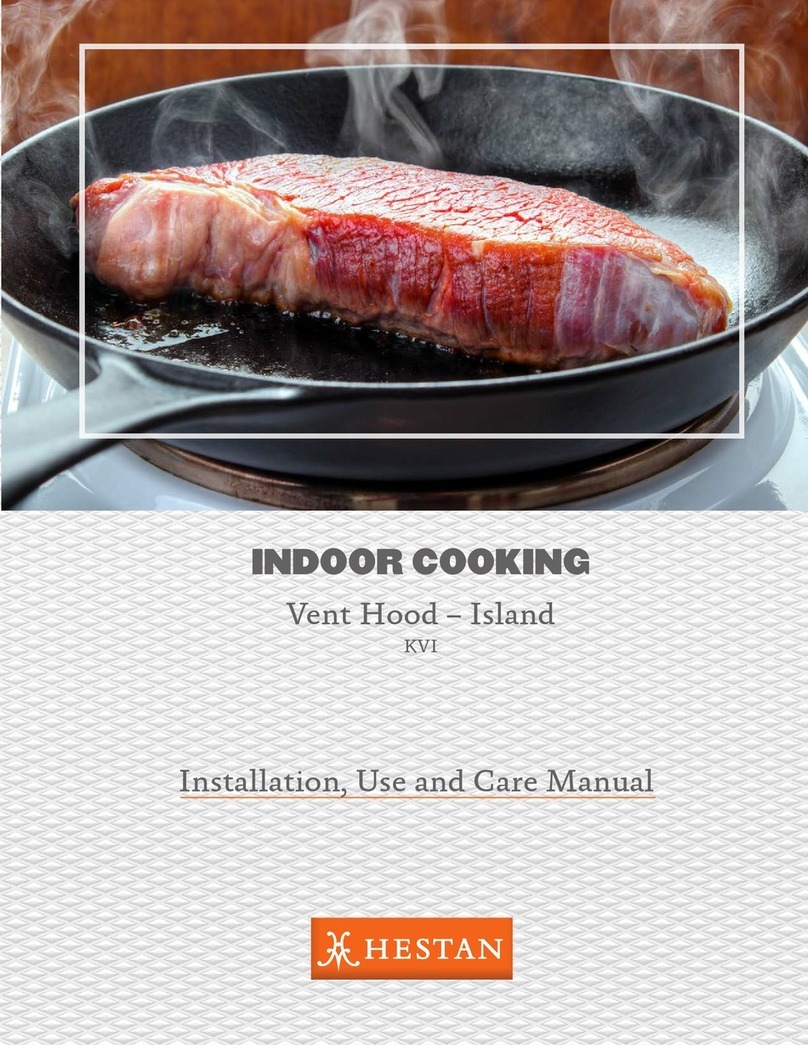
hestan
hestan KVI Instruction and safety manual
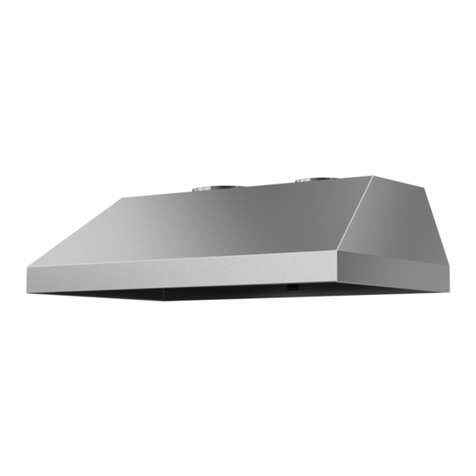
hestan
hestan KVL Series Instruction and safety manual
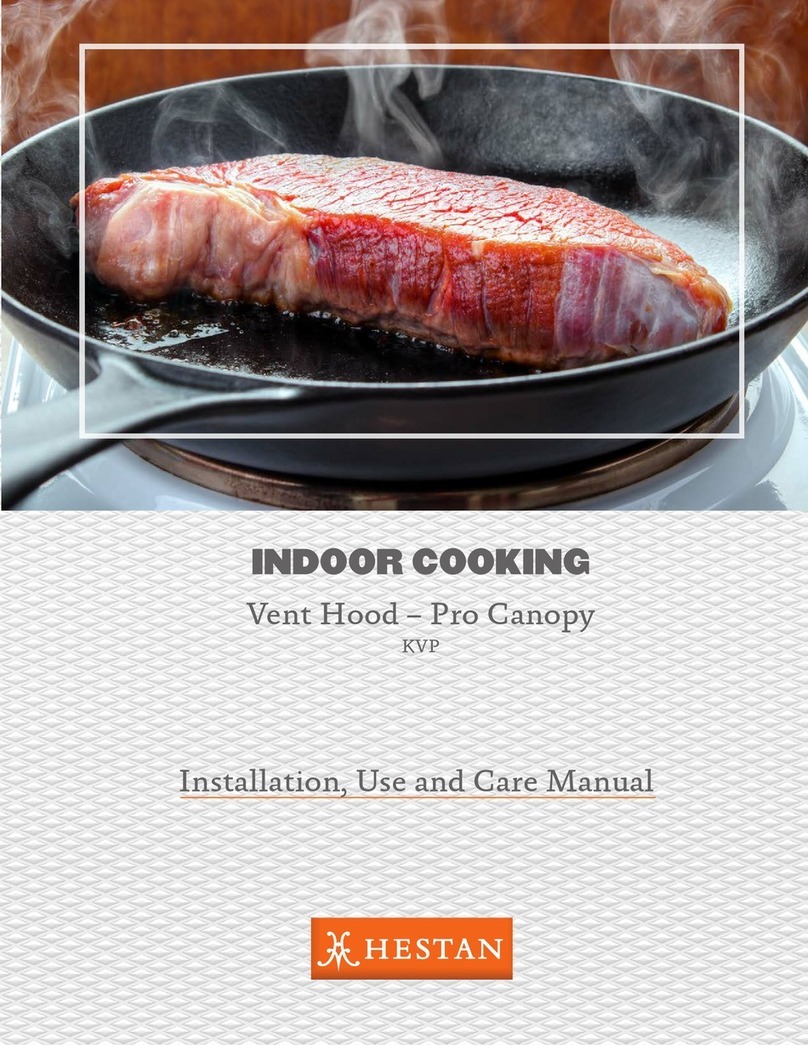
hestan
hestan Pro Canopy KVP Series Instruction and safety manual
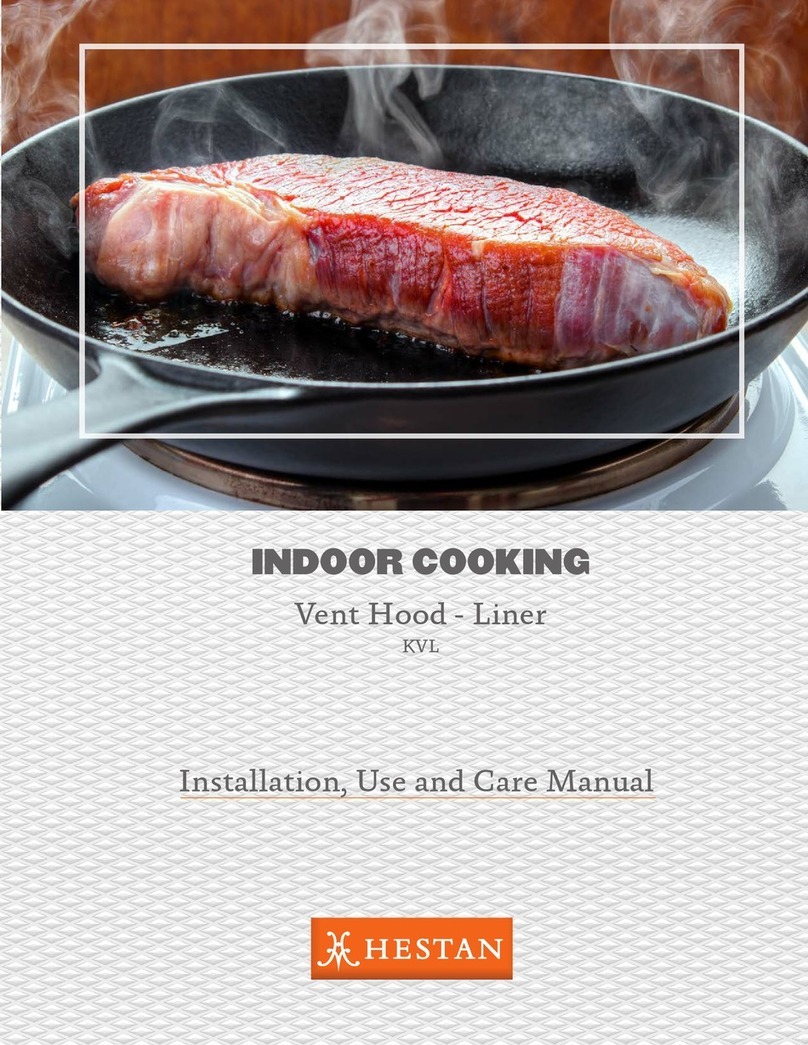
hestan
hestan KVL Instruction and safety manual
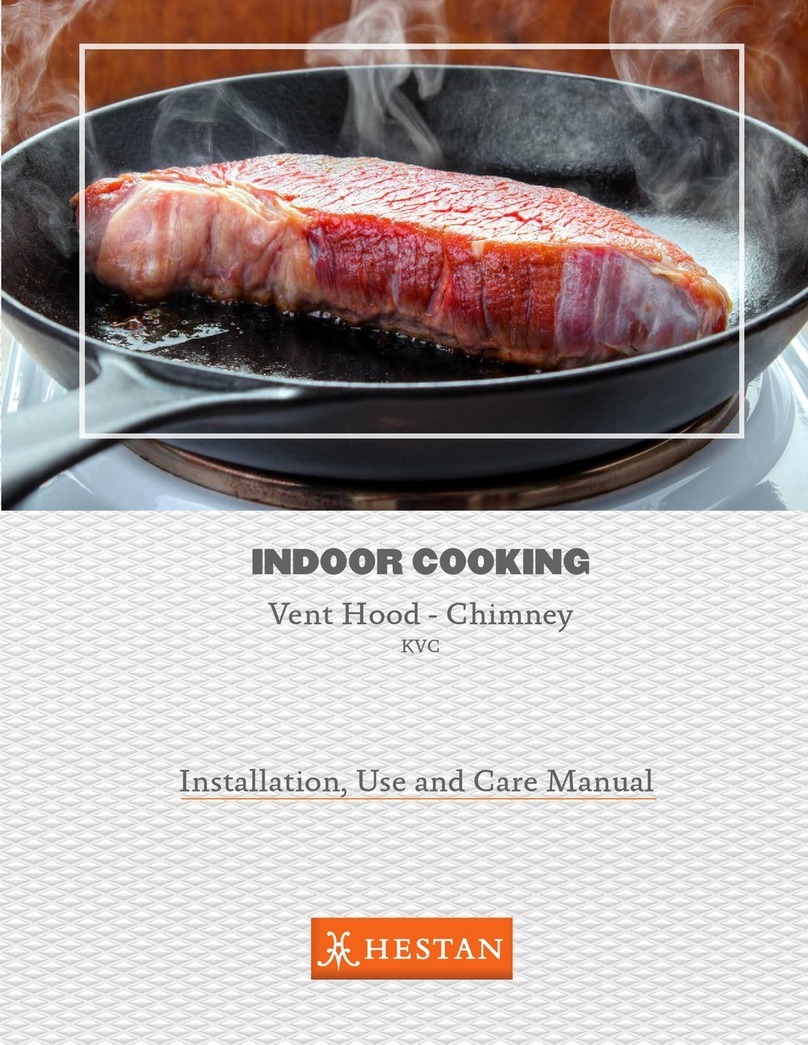
hestan
hestan KVC 30 Instruction and safety manual
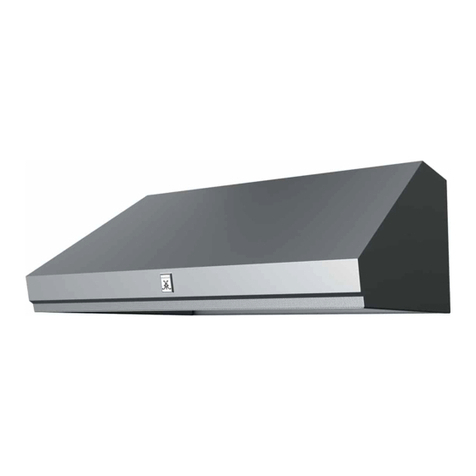
hestan
hestan KVP Series Instruction and safety manual

hestan
hestan KVP 30 Instruction and safety manual

hestan
hestan KVL Series Instruction and safety manual
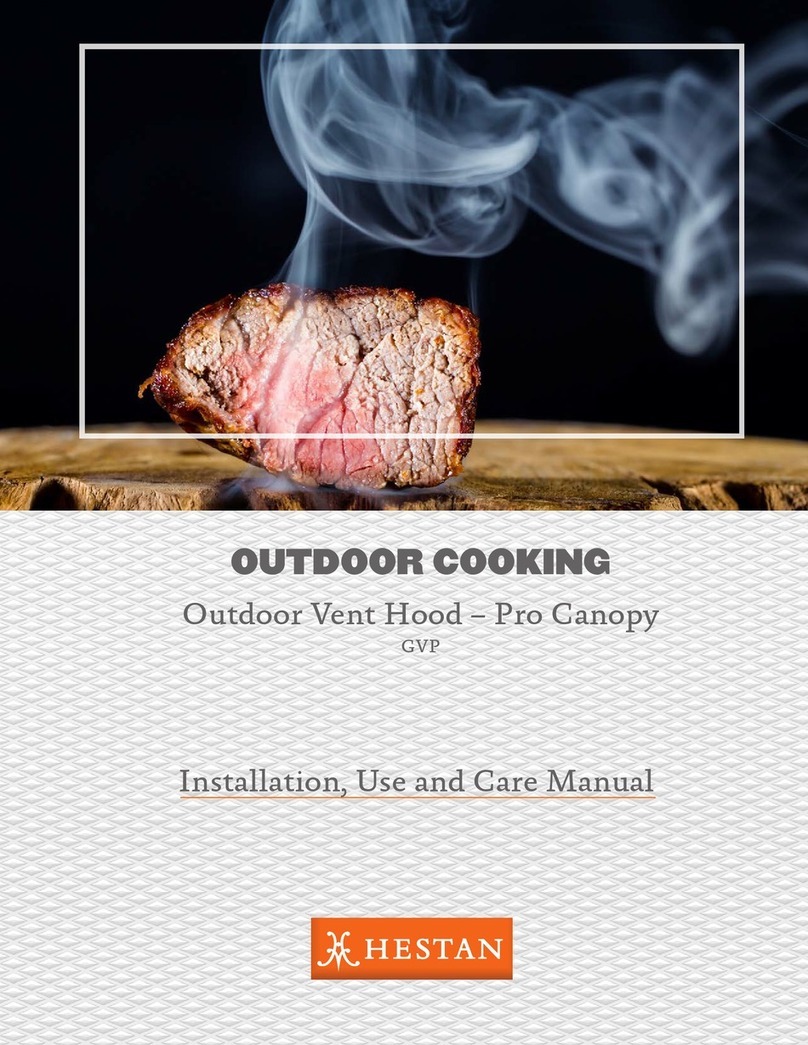
hestan
hestan GVP42 Instruction and safety manual
